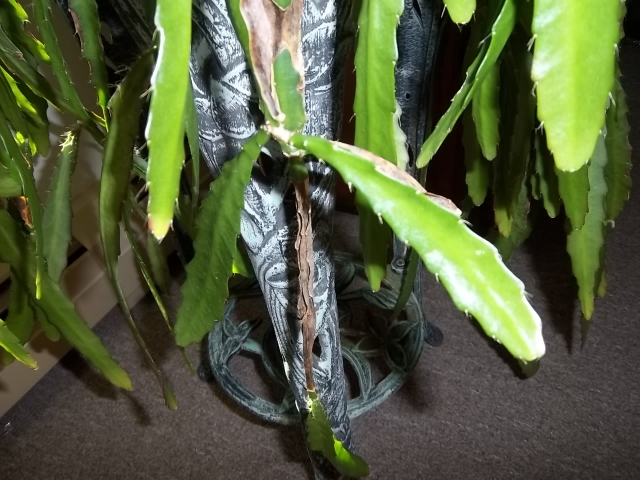Question
 Epiphyllum
Epiphyllum
I also have an epiphyllum that has area of dark brown dried up parts, but mine is growing from these dried up areas. There is new growth that is coming from the dried up part. I know nothing about these plants. It was given to me by a friend. It was very small when I got it, now it has grown very large. I have had it now three years. I like it a lot and don't want it to die. I also have never had it bloom.
AnswerFaye,
It is not growing from the dried up area, the dried up area died above the green part. The green part will slowly die also unless you cut it off and cut away the brown part then root the green part in a separate pot. I own a very large one that I have had for 10 years or more. It will not die, it just gets areas that die back occasionally and you can use the green ends to start new plants in a separate pot or fill in the pot you have.
Do you fertilize it? To get it to bloom you heed to fertilize. The brand of fertilizer you use matters little only the 3 numbers you see on every fertilizers label. The numbers stand for this in order (there抯 an example of one type of formula is below).
5-50-17 The first number 5 is nitrogen you want this zero or very low, under 10 best. The plant will get all the nitrogen it needs from the soil mix you gave it so it抯 not really needed at this time. The second number 50 is phosphorous you want this high or over 20. The last number is potassium this can be under 20. So the middle number is what you want high. What do this numbers mean? There just the percentage of each macro nutrient 5% nitrogen, 50% phosphorous and 17 % potassium. That抯 a total of 72%. What抯 the other 28%? Well if its liquid probably just water. If its granular maybe gypsum which is inert like caulk, it抯 in the drywalls of your house. It doesn't matter really but the higher the numbers the more your getting for the volume versus cost of the product. These formulas will all push blooms.
5-50-17, 11-54-4, 6-40-10 etc. Now that we have the right kind of fertilizer in mind lets move on to when to apply so you can get some blooms.
Epis don抰 grow much Nov. to almost end of Feb. until spring arrives, but beginning in mid to end of January while still semi-dormant and following each fertilizers suggested mix rates with water, apply bloom fertilizer mentioned above in 10 days to 2 week intervals. The plants on the first three or four applications might not show any signs of buds, but to get buds you have to gradually build that second number up in the plant. If you follow this schedule in January up to mid or end of March you will notice several buds develop. Lightly water in the fertilizer after each application,rinse it off the stems no heavy watering of the soil mix unless very dry. Continue applying as buds develop and stop once the buds open around mid April to June. Each variety starts buds and bloom at slightly different times, some are early some late. A few are off-season bloomers and could bloom in December but theres not many of those. Once buds do appear and are semi-developed be careful not to water too much this will cause many of the buds to drop or fall off.In fact if its overcast don't water, wait until its sunny enough for any residual moisture or water on the buds and stems to evaporate quickly. What tends to happen when the buds get soaked is they get mushy then bacteria sets in and the plant just lets it fall off. Remember the buds are big and theres many large moisture filled petals in there already extra moisture is not needed.
Keep in mind the formulas I mentioned above are very high so after blooming repot each plant soon after to replenish the huge amount of energy it takes to produce the very large and vividly colored blooms.
From Nov. until you start the fertilizer program do not water the plant. It will be dormant and water will tend to cause root rot. When you are fertilizing give it minimal water. The 1st of April it will start growing more and you can start watering more.
If you have more questions feel free to write again. Good luck!
Darlene






